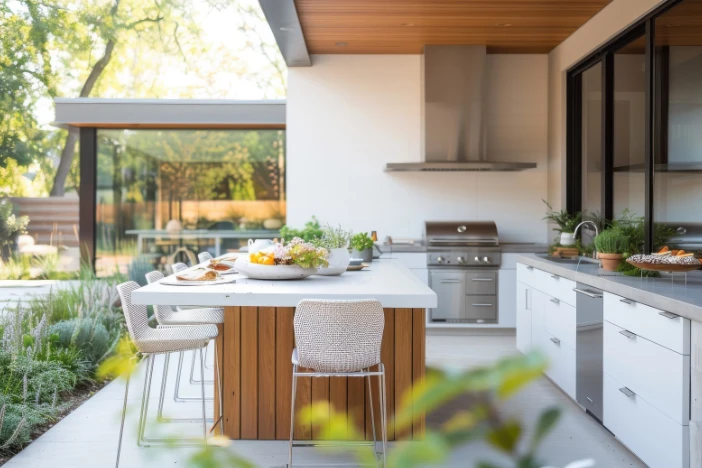
In a survey done by Toast, 54% of respondents said they were more likely to choose a restaurant with outdoor seating. In fact, 70% said they’re willing to wait longer for it!
But why go to a restaurant and waste your precious time if you’ve got an amazing deck or patio? Sure, it may need to be spruced up and revamped, but with enough thought, consideration, and planning, you can convert it into a fantastic outdoor kitchen and dining space to entertain in.
So where do you start and how can you build an outside kitchen that works with your unique space and needs? Read on to find out the steps you need to take.

Weigh the pros and cons of an outdoor kitchen
Before you go browsing simple outdoor kitchen ideas, you should first weigh up the pros and cons of creating an outdoor kitchen. Taking a moment to logically assess your situation may save you time, money, and energy in the long run.
Pros
Adding an outdoor kitchen to your home can increase its value, making it a great return on investment. It’ll also expand your living space and make it easier and roomier for social gatherings.
Plus, cooking outside keeps the heat and food smells outside. As a result, your indoor space will remain cool and odor-free.
Cons
Outdoor kitchen plans aren’t cheap; they can be expensive to build and equip. And since you’re getting a fully functional kitchen, you’ll have the added costs of gas, plumbing, and electrical connections.
It’ll take effort to maintain your outdoor kitchen as well. Not only do you have to use protective coverings in harsh climates, but you’ll also have to perform regular cleaning and upkeep to prolong the life of the appliances, etc.
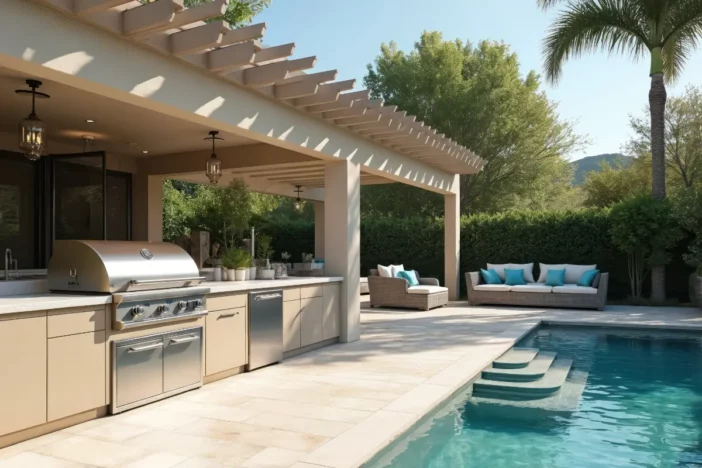
Pick the right location
So you’ve gone through the list of pros and cons, and you’ve decided that it’s a smart decision to move forward. In that case, the first part of outdoor kitchen design is choosing the right location. The three things to keep in mind are: Convenience, Comfort and Functionality.
Most homeowners should consider putting their outdoor kitchen close to the house, so you won’t have to go far to bring things in and out of the home to the kitchen. Plus, it’ll be easier to access utilities like electricity, water and gas.
You should also take the elements into account. The grill should be in a position where smoke flows away from seating areas for both dining and lounging. Consider putting in natural shading or pergolas, umbrellas, or awnings for protection from the sun and rain.
The kitchen should be in an area with privacy as well. But if you don’t want to be staring at a wall, you’ll have to choose carefully to get a nice view while maintaining privacy from your neighbors.
Most importantly, before starting construction, check local building codes and regulations to ensure you’re compliant.

Set a realistic budget
You may have already guessed, but the cost of building an outdoor kitchen can vary widely. What you pay will depend on the size, materials, and features you desire.
According to Angi, you can pay anywhere from $1,000 on the low end to $60,000 on the high end. However, the normal range is $6,348 to $26,903, with the average being $16,480.
When budgeting, prioritize essential features first, such as the grill, storage, and counter space. If you want to save some money, you can DIY parts of the kitchen if you’ve got experience and skills. You can also consider phased installations to spread costs over time.
If you have some room in your budget, invest in the most weather-resistant materials. That way, you can avoid costly repairs in the future.
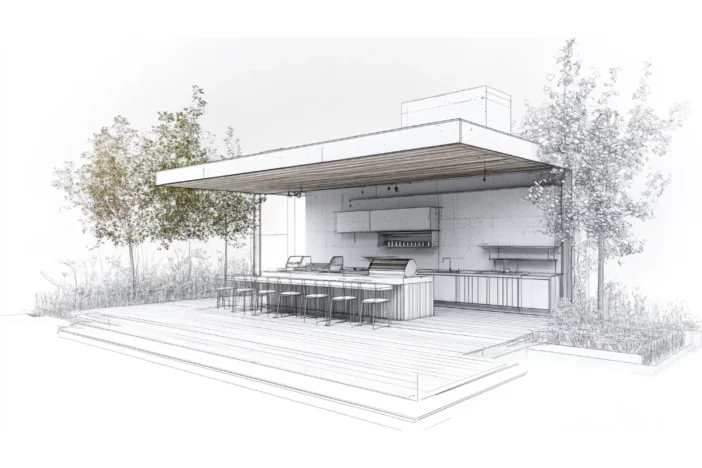
Plan the layout
The goal of your kitchen layout should be to enhance functionality and efficiency. Here are the most common layouts.
- Straight-line – In this layout, everything’s in a single row. It’s ideal for small spaces, as it can give off the illusion that you have a bigger space than you really do. They’re usually paired with a separate dining table off to the side.
- Galley – A galley-style kitchen is great when a straight-line design can’t accommodate enough appliances. The parallel islands make it easier for multiple people to cook at the same time. Different zones can be reached by simply turning instead of moving along one island.
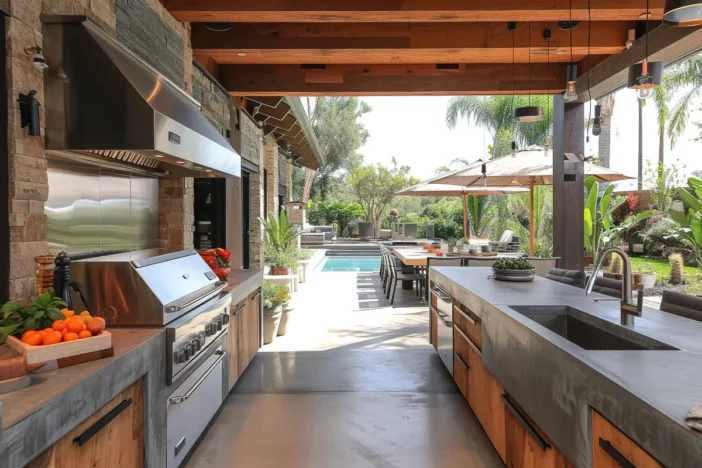
- L-Shaped – An L-shaped kitchen gives you more counter space and creates a natural cooking flow. It’s the most popular design as it enables you to integrate cooking and entertaining areas on separate legs.
- U-Shaped – A U-shaped kitchen has the most workspace. It provides room for designated areas for different tasks, keeping you more organized. It also creates a naturally cozy gathering place where hosts can easily interact with guests during meal preparation.
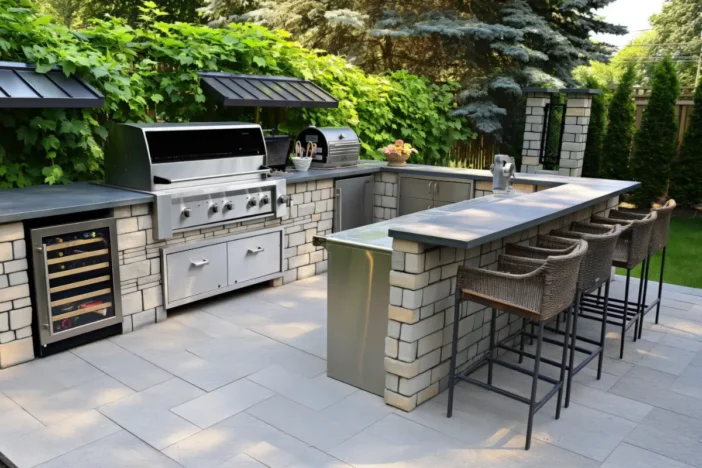
Understand the kitchen work triangle and work zones
The kitchen work triangle is a concept that optimizes efficiency regarding the three main components: cooking (grill), refrigeration, and sink. These are placed in a triangular configuration, which then minimizes movement while you’re prepping and cooking.
You can also divide your outdoor kitchen into several functional zones. For example, these are the most commonly used ones:
- Cooking Zone – Cooking appliances such as the grill, smoker, burners and pizza oven
- Prep Zone – Open counter space for cutting boards, knife blocks, and paper towel racks with a sink and dishwasher for easy clean-up
- Plate & Serve Zone – Counter space for serving dishes, plates and a built-in warming drawer
- Entertainment Zone – Cooling appliances like a refrigerator and ice maker, plus bar equipment (should be away from cooking heat)
If you organize your outdoor cooking area, then it’ll improve your workflow and reduce clutter too. As a result, you’ll have more space to place your outdoor dining table without it feeling claustrophobic.
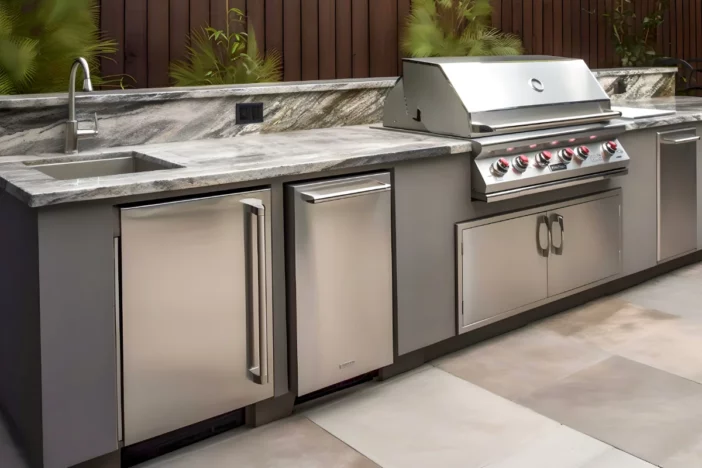
Select the right appliances and equipment
Your outdoor grill area won’t be anything special unless you choose the right appliances and equipment to go in that space. While shopping, keep your cooking style and outdoor lifestyle in mind to make smart decisions.
The grill will be the centerpiece of any outdoor kitchen, and you can pick from either gas, charcoal, or hybrid grills. Adding side burners can be great, as they’re perfect for sauces, boiling water, or cooking delicate dishes.
BBQ enthusiasts will also want to buy a smoker for the ultimate meat fest! And why not throw in a pizza oven for gourmet outdoor cooking?
Other things to consider include:
- Refrigerator and ice maker
- Sink and dishwasher
- Warming drawer
Don’t forget to maximize storage solutions too. For instance, you can use pull-out trash and recycling bins to keep waste hidden. Or you can have built-in spice racks and shelves for convenient access to ingredients and enclosed pantry space to protect your dry goods from humidity.

Factor in plumbing and gas
Proper plumbing and gas connections will definitely make your outdoor kitchen more efficient.
If you’re installing a sink or dishwasher, then a cold-water line is usually enough. However, a hot-water line adds convenience, so think about how often you’ll use it to determine if it’s worth the added trouble.
Even without the hot-water line, you’ll probably need gas to power your appliances. Natural gas lines are cost-effective in the long run, but do require professional installation. You can go for propane tanks instead since they offer flexibility, but they do need frequent refills.
Lastly, ensure there are plenty of electrical outlets for everything that needs power, such as your refrigerator, lighting, and other appliances. Install GFCI (ground fault circuit interrupter) outlets for safety, and always hire a licensed professional for gas and plumbing work.
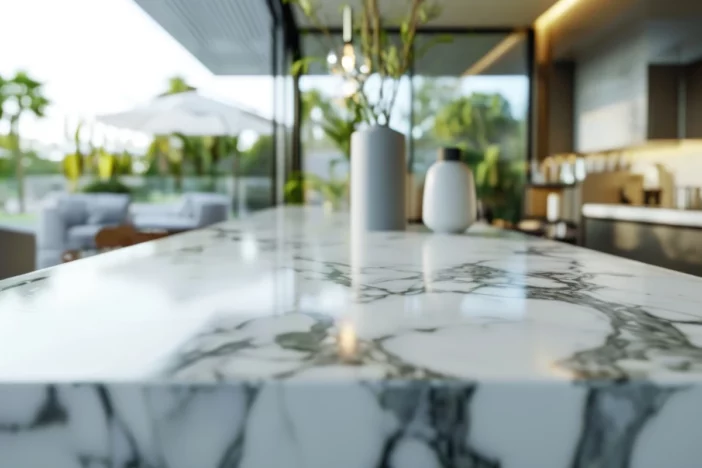
Choose the best materials for durability
You want your outdoor kitchen to withstand the tests of time, so this means choosing the most durable materials possible. This can be a tall order though, as not only do your countertops have to be heatproof, but also weather-resistant and easy to clean.
For countertops, granite is an excellent choice since it’s heat and weather-resistant, plus it’s stylish. However, it needs sealing, and it can be expensive.
Concrete’s a good alternative, as it’s highly durable and customizable. It also requires sealing, and it may crack over time.
For a modern look, turn to stainless steel. While it’s prone to scratches and can get hot in direct sun, it’s easy to clean.
For cabinetry, weatherproof materials you can consider include:
- Stainless steel
- Marine-grade polymer
- Treated wood
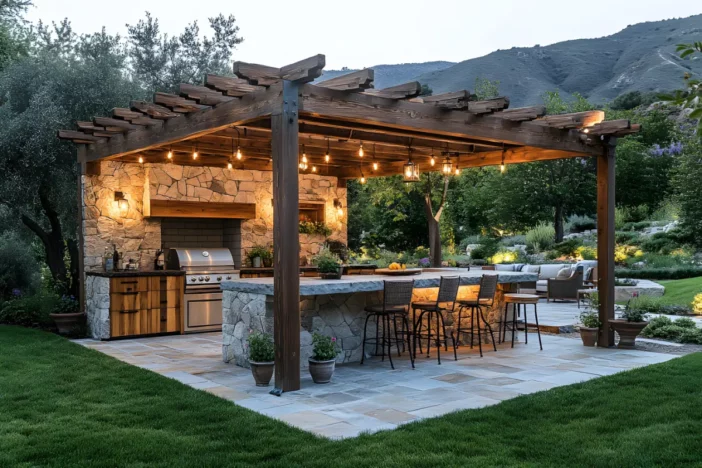
Get proper lighting for safety and ambiance
Outdoor kitchen lighting is vital not only for safety, but also for creating the perfect ambiance. You’ll have to place the lights strategically to ensure they’re both functional and atmospherical.
First, start with task lighting. These are the brightest lights and they should go over the cooking and prep areas so you can make food in a safe manner.
Then, add accent lighting, such as soft LED or string lights. These can enhance the atmosphere and give additional lighting without it being too harsh.
For safe movement around the kitchen, think about putting in pathway lighting. Motion sensor lights can help too, as they’ll improve security at night.
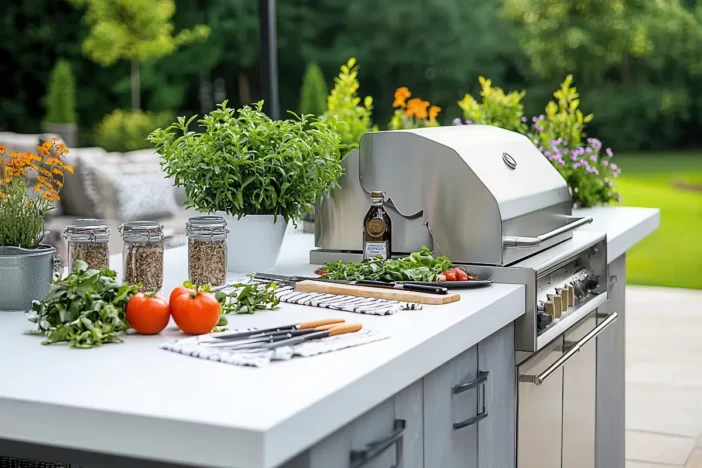
Design an amazing outdoor kitchen
An outdoor kitchen can be wonderful to have, especially if you like to eat outside and make good use of your backyard. However, it takes careful consideration to bring the perfect kitchen to life.
If you use the information given in this article though, you’ll be able to select the right materials and appliances to optimize your layout. The result will be a functional and stylish outdoor kitchen that enhances your home and lifestyle.





Leave a Reply